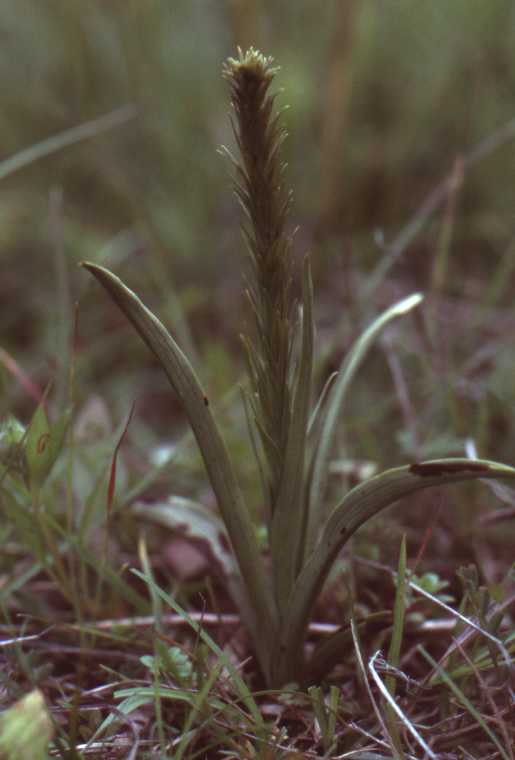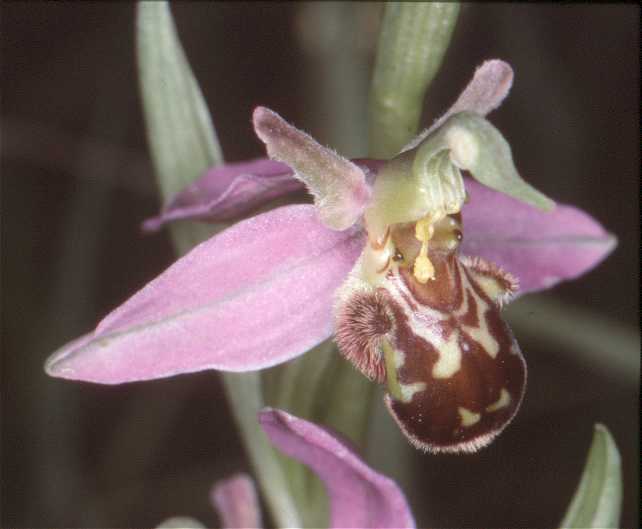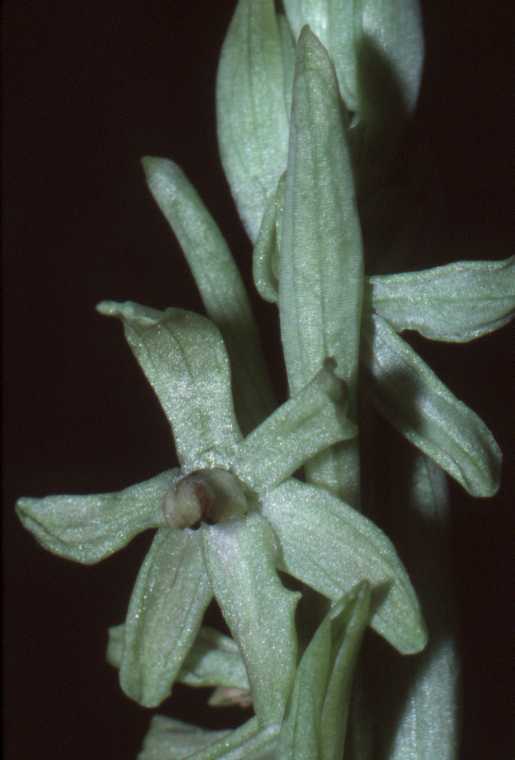|
ORCHIDS OF EUROPE WRONG STRUCTURES |
||
 In
addition to hybrids and wrong coloured specimens the watchful observer sometimes
can find plants, which are less or more disfigured. This is called wrong
structure. In most cases the flowers, but sometimes also the whole habitus
or vegetetive parts are deformed. While normally hybrids and wrong colours
are of genetic nature, monstrosities also can be caused by mechanical damaging,
for example by the bite of insects, the kick of animals or by frost. In
such cases often only one flower shows the abnormity. But when all the flowers
of a plant or several plants are showing the same damage and this damage
can be observed every year, it is shurely a genetic defect. For examples
please look at Ophrys incubacea
and Gymnadenia conopsea.
In
addition to hybrids and wrong coloured specimens the watchful observer sometimes
can find plants, which are less or more disfigured. This is called wrong
structure. In most cases the flowers, but sometimes also the whole habitus
or vegetetive parts are deformed. While normally hybrids and wrong colours
are of genetic nature, monstrosities also can be caused by mechanical damaging,
for example by the bite of insects, the kick of animals or by frost. In
such cases often only one flower shows the abnormity. But when all the flowers
of a plant or several plants are showing the same damage and this damage
can be observed every year, it is shurely a genetic defect. For examples
please look at Ophrys incubacea
and Gymnadenia conopsea.
If the flowers are damaged, the plant mostly is steril. Therefore such wrong structures are very rare. They dissapear when they are dying and they appear at another place. But there is an exception. Species, which reproduce by autogamie like Ophrys apifera do not need pollination. So in this cases such aberrations can be more frequent, so some authors call them a subspecies. Two good examples are Ophrys apifera ssp. botteronii and Ophrys apifera ssp. aurita.
 A
lot of wrong structures can be found. Concerning the damage of flowers the
whole blossom can be damaged (Ophrys
bombyloflora) or, more often, the flowers have more than one labellum
(Orchis palustris, Ophrys
lutea). In other cases the labellum is missing completely or it looks like
the two other petals. In this cases the flower is completely symmetric like
a lily or the two outer sepals are pointed downwards, rarely seen by Ophrys
holoserica. Very rare parts of the outer sepals have the signs and colours
of the labellum. For example please see Ophrys
garganica.
A
lot of wrong structures can be found. Concerning the damage of flowers the
whole blossom can be damaged (Ophrys
bombyloflora) or, more often, the flowers have more than one labellum
(Orchis palustris, Ophrys
lutea). In other cases the labellum is missing completely or it looks like
the two other petals. In this cases the flower is completely symmetric like
a lily or the two outer sepals are pointed downwards, rarely seen by Ophrys
holoserica. Very rare parts of the outer sepals have the signs and colours
of the labellum. For example please see Ophrys
garganica.
 When
the whole inflorescence is damaged, it could be curved (Listera ovata, Ophrys
archipelagi) or the flowers are pointed upwards which means they
are located to the wrong direction. In this case the plant is not able to
do the resupination, which mean the turnover of the flower buds for 180
degrees. For this you must know, that the flower buds are formed with the
labellum pointed upwards. But before opening the flowers by many, but not
all orchid species they will turn for 180 degrees, therefore the labellum
is pointed downwards. Very rarely the inflorescence is forked (Gymnadenia
conopsea) or flowers are formed in the rachis (Orchis
laxiflora).
When
the whole inflorescence is damaged, it could be curved (Listera ovata, Ophrys
archipelagi) or the flowers are pointed upwards which means they
are located to the wrong direction. In this case the plant is not able to
do the resupination, which mean the turnover of the flower buds for 180
degrees. For this you must know, that the flower buds are formed with the
labellum pointed upwards. But before opening the flowers by many, but not
all orchid species they will turn for 180 degrees, therefore the labellum
is pointed downwards. Very rarely the inflorescence is forked (Gymnadenia
conopsea) or flowers are formed in the rachis (Orchis
laxiflora).